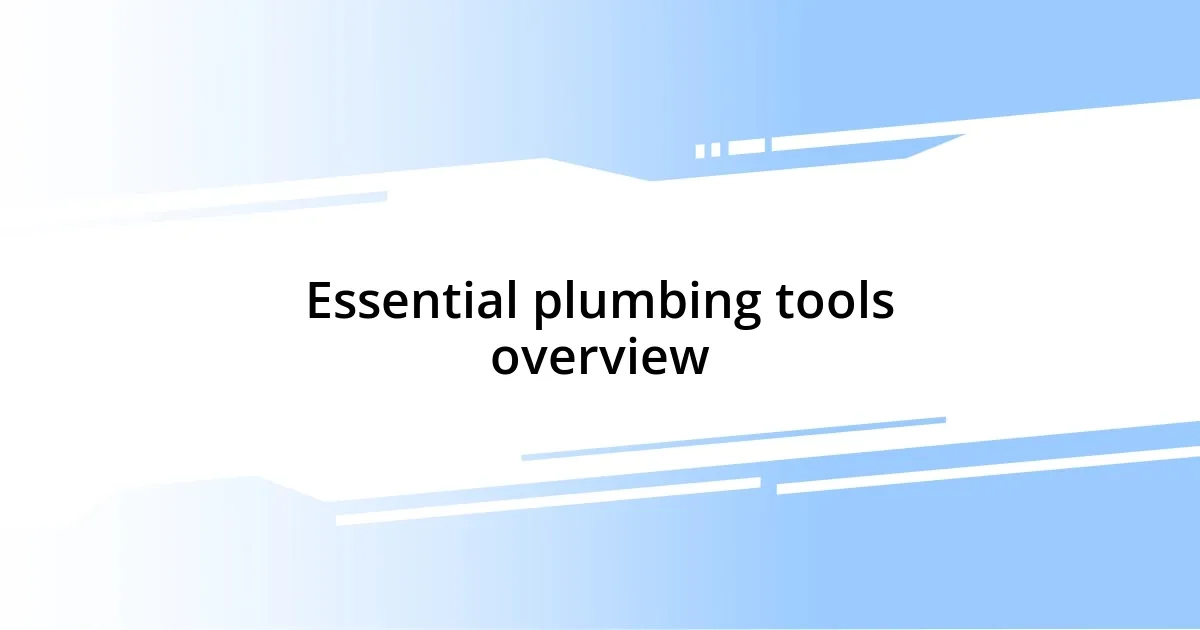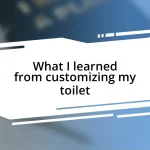Key takeaways:
- Essential plumbing tools include a pipe wrench, plunging solution, and adjustable pliers for effective emergency repairs and clogs.
- Choosing the right pipe wrench involves considering size, tooth type, material quality, comfort, and style to avoid frustration.
- Durable fittings, particularly brass and stainless steel, are crucial for long-lasting plumbing systems and should withstand pressure needs.
- Regular maintenance of plumbing tools, such as cleaning, sharpening blades, and lubricating moving parts, enhances their performance and longevity.

Essential plumbing tools overview
When it comes to essential plumbing tools, I often find myself leaning heavily on a reliable pipe wrench. This tool isn’t just a staple; it’s a lifeline during emergencies. I remember the first time I tackled a leaky faucet—having that sturdy wrench firmly in my grip made me feel like I could conquer anything.
Another indispensable tool I can’t live without is the plunging solution. That moment of panic when I faced a clogged drain taught me its true worth. Just imagine the relief I felt when that stubborn blockage finally budged. It’s a powerful reminder of how the right tool can transform a stressful situation into a manageable task.
Then there are the simple yet versatile adjustable pliers. These have saved me on countless occasions, whether I’m tightening a fitting or holding something steady. Isn’t it fascinating how often the most straightforward tools can make such a significant difference? I often ask myself, would I have been as confident in my plumbing skills without them?

Choosing the right pipe wrenches
Choosing the right pipe wrenches boils down to understanding the specific tasks you’ll tackle. I remember a time when I underestimated the significance of choosing the right size. I grabbed a too-small wrench for a stubborn pipe; let me tell you, that experience taught me the hard way that a proper fit can save hours of frustration.
Here are some key points to consider when selecting a pipe wrench:
- Size matters: Ensure it matches the diameter of the pipes you’ll work with. A wrench that’s too big can slip, while one that’s too small may not grip securely.
- Tooth type: Look for a wrench with sharp, strong teeth for a secure grip. Dull teeth can lead to slippage, costing you time and effort.
- Material quality: Opt for a wrench made of durable materials, such as steel, to ensure longevity and reliability.
- Comfort: Consider the handle’s design—comfortable grips can significantly reduce hand fatigue during long tasks.
- Style: There are various types of pipe wrenches, including straight and offset. Each serves different purposes, so choose according to your specific plumbing needs.
Taking the time to choose the right pipe wrench can vastly improve your plumbing experience and success.

Best fittings for durability
When it comes to selecting fittings for long-lasting durability, I’ve learned that materials matter immensely. My preference often leans towards brass and stainless steel fittings. In my experience, brass fittings resist corrosion better than many others. I recall a project where I replaced old copper fittings with brass; not only did it enhance the longevity of my plumbing system, but it also saved me from future headaches.
Another important consideration is how well the fittings can handle pressure. For instance, I once overlooked the importance of high-pressure ratings in a set of PVC fittings, and let me tell you, the resulting leak had me scrambling for the right tools late at night. Now, I always ensure that the fittings I use are rated for the demands of the job. It’s a lesson learned the hard way, but it’s one I can’t stress enough.
I also advocate for double-threaded fittings. They provide additional connections and can significantly improve the seal. I had a situation once where using a double-threaded fitting made it so much easier to connect a valve without leakage compared to single-threaded options. It just goes to show that sometimes the extra investment in quality fittings can save you both time and frustration in the long run.
| Material | Durability |
|---|---|
| Brass | Highly resistant to corrosion, lasts long |
| Stainless Steel | Withstands high pressure and oxidation |
| PVC | Lightweight, but check pressure ratings |
| Double-Threaded Fittings | Improved seals and easier connections |

Recommended drain cleaning tools
When it comes to drain cleaning, I have a few tools in my arsenal that have always delivered great results. One of my absolute favorites is a heavy-duty plumber’s snake. I remember staring forlornly at a stubborn clog in my bathroom that a simple plunger couldn’t touch. The snake glided through the pipes, breaking up the blockage like it was nothing. It’s incredible how such a straightforward tool can turn a frustrating situation into a smoothly flowing drain.
Another essential tool is the hydro-jetter. This gadget might feel a bit daunting at first, but once you get the hang of it, it’s a game-changer. The first time I used it, I was amazed at how it transformed a slow drain into a speedy one. The high-pressure water jetting out clears out grease and debris like magic. Have you ever been surprised by how gunk can build up over time? This tool takes care of that buildup quickly, and it leaves my pipes sparkling clean.
Lastly, I can’t stress enough the utility of a good set of drain augers. I have a couple of different sizes, each tailored for various pipe diameters. One time, while working on a neighbor’s house, I grabbed the smaller auger to tackle a kitchen sink. It fit perfectly, and the satisfaction of clearing that clog swiftly brought a huge smile to my face. I’ve found that having an arsenal of these tools makes me feel prepared for any plumbing challenge. Isn’t it comforting to know you’re equipped to tackle those unexpected clogs?

Importance of a good plunger
A good plunger is vital for any homeowner or plumber, and I’ve come to appreciate its importance more than once. I recall a particularly hectic day when my kitchen sink decided to back up. With guests arriving soon, I felt the panic rising until I reached for my trusty plunger. It was incredible how quickly that simple tool restored order, turning a potential crisis into a minor inconvenience.
When choosing plungers, I always look for the classic cup design with a sturdy handle. I remember trying a cheap, flimsy version once, and it let me down at the worst possible moment. The handle snapped right as I was about to put some muscle into it, and I couldn’t help but laugh at the irony of a broken tool creating more frustration. Since then, I’ve learned that investing in quality pays off, especially during high-stakes plumbing moments.
I’ve also discovered a fascinating feature in some plungers—the bellows style—which can create more suction than conventional options. After grabbing one for a particularly stubborn toilet clog, I was astounded at its performance. Have you ever had that satisfying feeling when a tool just works perfectly? The bellows-style plunger changed my perspective on this often-overlooked tool; it’s not just a fixer, but sometimes a true lifesaver.

Evaluating specialized plumbing gadgets
When evaluating specialized plumbing gadgets, I always consider their ease of use and effectiveness. For instance, I remember my first encounter with a drain camera. Initially, it felt like a high-tech mystery, but once I started seeing the insides of the pipes on the screen, it was like peering into a hidden world. Have you ever wished to see what’s causing a blockage instead of guessing? This tool allows you to pinpoint issues quickly, saving you a lot of time and frustration.
Another gadget I’ve found to be invaluable is the pipe locator. The first time I used one, I felt like a treasure hunter. It guided me straight to a buried pipe that was causing drainage problems. The sheer relief of not having to dig everywhere just to find the issue was exhilarating. It made me wonder how I ever managed without it before! I believe that specialized tools open up new possibilities, making complex jobs manageable.
Lastly, let’s talk about specialized wrenches. I once tackled a stubborn toilet flange using a wrench that fit perfectly into those tight spaces. The overwhelming satisfaction I felt when that stubborn nut finally turned was euphoric. How often do we underestimate the significance of having the right tools for the job? I’ve learned that having a few specialized wrenches in my toolkit makes all the difference, allowing me to approach plumbing jobs with confidence and skill.

Maintaining your plumbing tools effectively
Maintaining plumbing tools isn’t just about keeping them clean; it’s crucial for ensuring their longevity and performance. I’ve learned that a quick rinse and drying after use can prevent rust and corrosion. Once, I neglected this step after clearing a stubborn sink blockage, only to find my favorite wrench covered in rust a week later. That reminder was bittersweet but solidified my commitment to proper care.
I also pay attention to the blades of my pipe cutters and saws. Keeping them sharp makes all the difference—I’ve experienced the struggle of a dull blade tearing through pipes instead of cutting cleanly. It’s frustrating and can lead to uneven cuts, which need rework. Now, I keep a designated sharpener in my toolbox so that I’m always prepared for my next project.
Lastly, I recommend regular lubrication for tools like faucets and hoses. I remember the dread of wrestling with a stiff hose while trying to fix a leak under the kitchen sink. The movement felt mechanical and clunky. After that experience, I started a schedule to lubricate my hoses, and now everything works smoothly. Isn’t it amazing how a little maintenance can transform a tool from reluctant to reliable? Keeping plumbing tools in top shape not only enhances their efficiency but also makes any plumbing job less daunting.














